Welcome to our guide on cat positive reinforcement techniques! If you’re a cat owner seeking effective methods to train and modify your feline companion’s behavior, this article is for you. By utilizing positive reinforcement techniques, you can create a happier and healthier environment for your beloved cat.
In this section, we will delve into the importance of positive reinforcement techniques in cat training and behavior modification. We will explore various techniques that can help foster positive cat behavior and establish a strong bond between you and your pet.
Key Takeaways:
- Positive reinforcement techniques are crucial for training and modifying cat behavior.
- Using rewards and praise helps to encourage desirable behaviors in cats.
- Clicker training can be a powerful tool for enhancing positive reinforcement training.
- Building a strong bond through play and rewards is essential for successful cat training.
- Addressing undesirable behaviors requires patience, consistency, and positive reinforcement techniques.
Understanding Cat Behavior
Before we dive into specific positive reinforcement techniques, it’s essential to understand basic cat behavior and how they learn. This section will provide insights into the natural behaviors of cats and how they can influence training and behavior modification.
Cats have distinct behaviors that are important to comprehend when training them. Understanding their natural instincts and tendencies will help you tailor your training approach to their individual needs.
1. Cats are independent creatures:
Unlike dogs, cats have a more independent nature. They value their personal space and enjoy their alone time. This independence can influence their response to training methods, and it’s important to respect their boundaries.
2. Communication through body language:
Cats use body language to express their feelings and intentions. By observing their posture, tail movements, and facial expressions, you can decipher their mood and adjust your training accordingly.
3. Playful and curious nature:
Cats are naturally curious and playful animals. They have a keen sense of exploration and enjoy interactive playtime. Incorporating play into your training sessions can make them more engaging and enjoyable for your feline friend.
4. Sensitivity to punishment-based training:
Cats tend to be sensitive creatures, and punishment-based training methods can be counterproductive. Negative reinforcement can lead to fear and anxiety, hindering the training process. Positive reinforcement techniques, on the other hand, encourage desired behaviors through rewards and praise.
By understanding these fundamental aspects of cat behavior, you’ll be better equipped to establish effective training techniques. Keep these insights in mind as we explore the power of positive reinforcement in the next section.
The Power of Positive Reinforcement
When it comes to training your cat, positive reinforcement is a powerful technique that can yield excellent results. Unlike punishment-based methods, positive reinforcement focuses on rewarding your cat for desired behaviors, creating a positive and rewarding training experience.
So, why is positive reinforcement so effective?
Positive reinforcement works by reinforcing behaviors that you want to see more of in your cat. When your feline friend performs a desired behavior, you can use rewards like treats, praise, or playtime to reinforce and encourage that behavior. Over time, your cat will associate the positive experience with the behavior, making it more likely to be repeated.
Using positive reinforcement techniques can help foster a strong bond between you and your cat. It promotes a trusting and loving relationship, as it focuses on encouraging good behavior rather than using punishment or force.
Here are some cat training tips to effectively use positive reinforcement:
- Reward immediately: It’s crucial to reward your cat immediately after they perform the desired behavior to reinforce the connection between the action and the reward.
- Be consistent: Consistency is key in cat training. Make sure to reward your cat every time they exhibit the desired behavior to reinforce the positive association.
- Use high-value rewards: Find out what treats or rewards your cat finds most enticing and use them as incentives during training sessions.
- Take baby steps: Break down complex behaviors into smaller achievable steps. Reward your cat for each step they successfully complete, gradually working toward the desired behavior.
- Keep sessions short and fun: Cats have short attention spans, so it’s essential to keep training sessions short and enjoyable. End each session on a positive note to keep your cat engaged and eager to participate.
Remember, training your cat takes time and patience. Stay positive and celebrate every small success along the way. With the power of positive reinforcement, you can effectively train your cat and create a harmonious environment for both of you.
Clicker Training for Cats
Clicker training is a highly effective technique that can significantly enhance positive reinforcement training for cats. By using a clicker device, you can precisely mark and reinforce desired behaviors in your feline friend.
So, how does clicker training work? It’s quite simple. The clicker serves as a distinct sound cue that signals to your cat that they have performed a behavior correctly and will receive a reward. This form of communication allows for precise timing, making it easier for your cat to understand the desired behavior.
Here’s how you can integrate clicker training into your cat’s training routine:
- Acquaint your cat with the clicker: Start by introducing the clicker as a positive and rewarding sound. Press the clicker and immediately follow it with a treat, repeating this process multiple times. This will help your cat associate the clicker sound with something positive.
- Select a behavior to train: Choose a simple behavior that you want to reinforce, such as sitting or coming when called.
- Click and reward: When your cat performs the desired behavior, click the clicker and immediately offer a treat or praise. Be consistent with the timing to reinforce the connection between the clicker sound and the reward.
- Repeat and reinforce: Practice the clicker training exercises regularly, gradually increasing the difficulty level as your cat becomes more proficient. Consistency and patience are key to successful clicker training.
Remember, clicker training should always be accompanied by positive reinforcement techniques. Use treats, praise, or playtime to reward your cat for their efforts.
By incorporating clicker training into your cat’s training routine, you can effectively reinforce positive behaviors and create a deeper bond with your furry companion.
Building a Bond Through Play and Rewards
Building a strong bond with your cat is crucial for successful training. Cats are social animals, and forming a deep connection with them can enhance their receptiveness to training techniques. In this section, we will discuss the importance of playtime and reward-based training in strengthening your relationship with your feline friend.
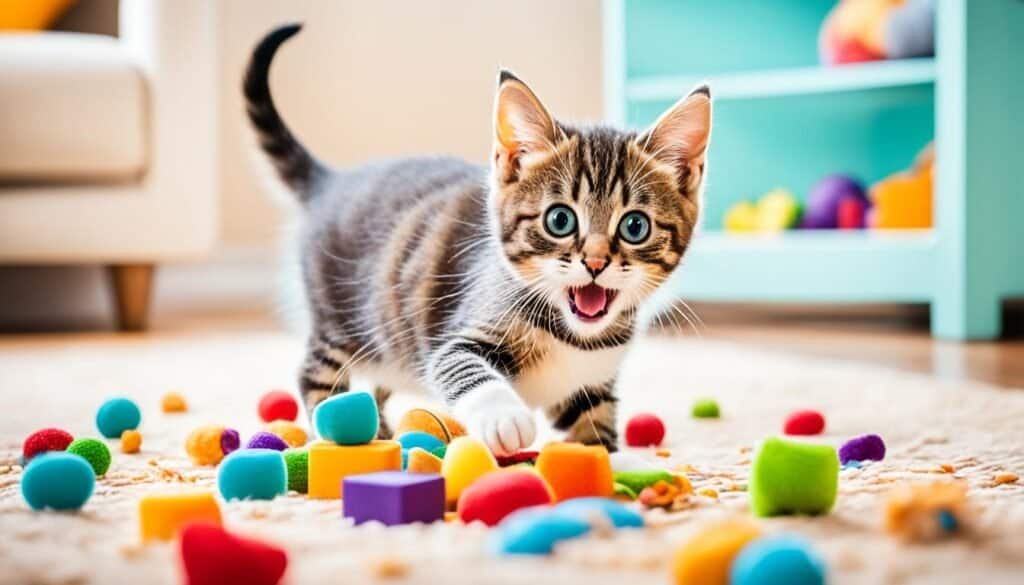
Playtime is not only a fun activity for your cat, but it also provides an opportunity for exercise, mental stimulation, and bonding. Engaging in interactive play sessions with toys such as feather wands, laser pointers, or puzzle toys can help relieve your cat’s energy and prevent them from engaging in unwanted behaviors.
During playtime, observe your cat’s preferences and behavior. Some cats may enjoy chasing objects, while others may prefer pouncing or batting. Tailor your play sessions to your cat’s individual preferences to ensure maximum enjoyment.
It’s important to incorporate reward-based training during playtime to reinforce positive behaviors. Whenever your cat displays desired behaviors, such as using a scratching post or using the litter box, promptly reward them with treats, praise, or a favorite toy. This positive reinforcement encourages your cat to repeat these behaviors in the future.
In addition to playtime, everyday interactions also contribute to building a bond with your cat. Take time to pet, groom, and communicate with your cat using a calm and soothing voice. These interactions help establish trust and reinforce the bond between you and your feline companion.
Key Tips:
- Engage in regular interactive play sessions with your cat to provide mental stimulation and bonding opportunities.
- Observe your cat’s play preferences and tailor play sessions to suit their individual needs.
- Use reward-based training during playtime to reinforce positive behaviors and encourage repetition.
- Take time for everyday interactions such as petting, grooming, and communicating with your cat to strengthen your bond.
Addressing Undesirable Behaviors
Cats can occasionally exhibit behaviors that may be undesirable or problematic for their owners. However, with the right approach and effective cat training techniques, these behaviors can be successfully modified. In this section, we will explore positive reinforcement methods that can help address common cat behavior issues, such as scratching furniture or excessive meowing.
1. Scratching Furniture
One of the most common concerns for cat owners is their pets’ tendency to scratch furniture. This natural behavior can damage your beloved belongings. To redirect your cat’s scratching behavior, follow these steps:
- Provide appropriate scratching posts or boards that appeal to your cat’s preferences. Experiment with different materials, such as sisal rope or cardboard, to determine what your cat prefers.
- Place the scratching posts near the furniture your cat tends to scratch, gradually moving them away over time.
- Encourage your cat to use the scratching posts by sprinkling catnip on them or using interactive toys to engage their interest.
- Offer praise and rewards every time your cat uses the scratching post instead of the furniture. Positive reinforcement will help reinforce the desired behavior.
2. Excessive Meowing
If your cat’s meowing becomes excessive and bothersome, it’s important to understand the underlying reasons for this behavior. Here are some strategies to address excessive meowing:
- Ensure your cat’s basic needs, such as food, water, and a clean litter box, are met.
- Engage your cat in regular play sessions and provide mental stimulation to prevent boredom.
- Consult with a veterinarian to rule out any underlying medical issues that might be causing excessive meowing.
- Avoid reinforcing the meowing behavior by not responding to it or feeding into your cat’s demands.
- Use positive reinforcement techniques to reward your cat for remaining calm and quiet.
By implementing these positive reinforcement techniques, you can effectively address unwanted behaviors in your cat and create a harmonious living environment for both you and your feline companion.
Environmental Enrichment for Cats
A stimulating environment is essential for a happy and well-behaved cat. To prevent boredom and encourage desirable behaviors, it’s important to provide your feline friend with an environment that engages their natural instincts and provides ample opportunities for mental and physical stimulation.
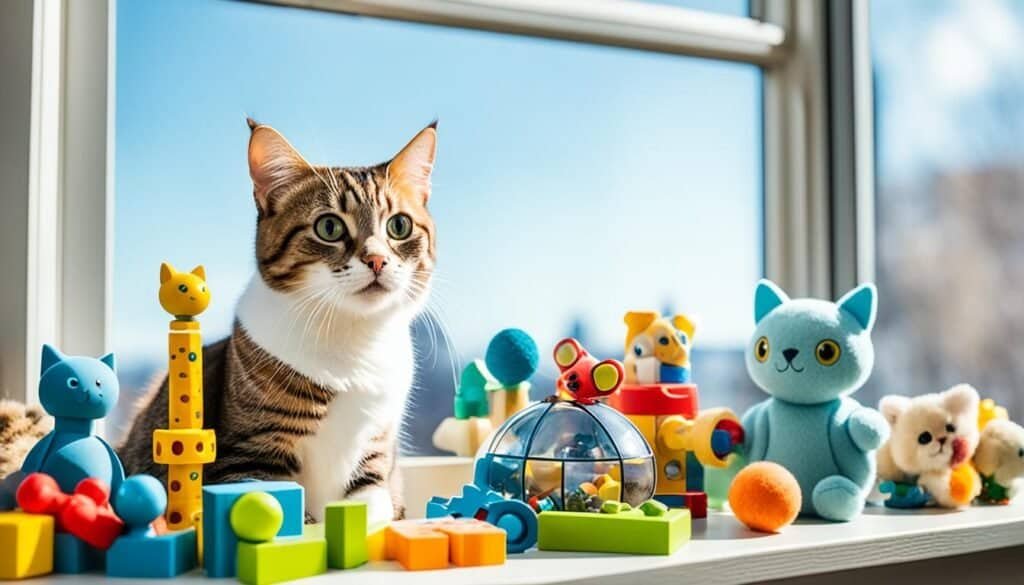
Create Vertical Space
Cats have a natural inclination to climb and perch in high places. Provide vertical space in your home by installing cat trees, shelves, or wall-mounted perches. These elevated areas not only give your cat a sense of security but also provide mental stimulation as they explore their surroundings from different heights.
Offer Interactive Toys and Puzzles
Engage your cat’s natural hunting instincts and keep them mentally stimulated by providing interactive toys and puzzles. Toys that simulate prey-like movements or hold treats inside can keep your cat entertained for hours. Puzzle toys challenge your cat’s problem-solving skills and provide a rewarding experience when they successfully retrieve treats or toys.
Provide Hiding Places
Cats often seek out small, enclosed spaces for relaxation and security. Create hiding places in your home using cat tunnels, cozy beds, or even cardboard boxes. These hiding spots give your cat a space of their own where they can retreat and feel safe.
Rotate Toys and Playtime
Keep your cat’s environment engaging by regularly rotating their toys and varying their playtime routines. Introducing new toys or bringing out previously hidden toys can reignite your cat’s interest and prevent them from getting bored. Additionally, incorporating different play styles such as interactive play, chasing toys, or playing with a laser pointer can cater to their changing interests and keep them mentally stimulated.
Provide Window Views
Allowing your cat access to window views can provide them with hours of entertainment. Place a cat-friendly window perch or even a comfortable chair near a window. Watching birds, squirrels, or other outdoor activities can help to satisfy their natural curiosity and stimulate their senses.
By incorporating these environmental enrichment techniques, you can help promote a happier, healthier, and well-behaved cat. Providing a stimulating environment that addresses their natural instincts will go a long way in preventing behavior issues and ensuring a harmonious relationship between you and your feline companion.
Patience and Consistency in Cat Training
When it comes to training your cat, patience and consistency are paramount. Cats, like any other animals, require time, repetition, and a structured routine to fully grasp the training concepts. In this section, we will delve into the significance of patience and consistency in cat training and provide you with effective strategies for maintaining a consistent training routine.
Patience:
Training a cat can be a time-consuming process, and it’s important to remember that each cat is unique and learns at their own pace. Some cats may pick up new behaviors quickly, while others may require more time and practice. Patience is key in allowing your cat to progress at their own speed without feeling rushed or pressured.
When introducing a new behavior or command to your cat, start by breaking it down into smaller steps. This makes the training process less overwhelming and allows your cat to master each step before moving on to the next. If your cat doesn’t seem to be catching on, remain patient and avoid getting frustrated. Instead, continue to reinforce the desired behavior with positive rewards and give your cat the time they need to understand and respond.
Consistency:
Consistency is essential in cat training as it establishes clear expectations and reinforces desired behaviors. Cats thrive in stable environments, and a consistent training routine helps them understand what is expected of them.
When implementing a training routine, ensure that all family members or individuals involved in your cat’s care are on the same page. Consistency in commands, rewards, and expectations helps avoid confusion and ensures that your cat receives consistent reinforcement for desired behaviors.
It’s also important to establish a consistent schedule for training sessions. Set aside dedicated time each day to work on training with your cat, focusing on one behavior at a time. Short, frequent training sessions are more effective than long, sporadic ones. Remember to use positive reinforcement techniques such as praise, treats, or clicker training to reward your cat for their efforts and progress.
Consistency extends beyond training sessions. Consistently reinforce desired behaviors throughout your cat’s daily routine. For example, if you’re training your cat not to scratch the furniture, consistently redirect their attention to a scratching post and reward them for using it. By providing consistent guidance and reinforcement, your cat will learn and internalize the expected behaviors more effectively.
By practicing patience and maintaining consistency in your cat’s training, you are setting them up for success. Remember, every step forward, no matter how small, is progress in the right direction. With time and dedication, you’ll witness the positive results of your efforts as your cat becomes a well-trained and happy companion.
Conclusion
In conclusion, implementing cat positive reinforcement techniques can have a profound impact on the well-being and happiness of your furry friend. By utilizing reward-based training methods, addressing unwanted behaviors, and fostering a strong bond through play, you can establish a harmonious relationship with your feline companion.
Positive reinforcement is a powerful tool in cat training, as it focuses on rewarding desired behaviors instead of punishing unwanted ones. This approach not only encourages your cat to repeat good behavior but also helps strengthen the trust and bond between you and your pet.
Remember to be patient and consistent in your training efforts. Cats learn at their own pace, and it may take time for them to fully grasp and internalize new behaviors. Celebrate small victories along the way and adjust your training techniques as needed to ensure continued progress.
By implementing cat positive reinforcement techniques, you can create a nurturing environment that promotes your cat’s natural instincts and encourages them to thrive. So, start incorporating these techniques into your training routine and enjoy the rewarding experience of watching your cat flourish.
FAQ
Why is cat positive reinforcement techniques important in cat training?
What are some positive cat behavior techniques?
How does clicker training work for cats?
How can I build a bond with my cat through play and rewards?
How can I address undesirable behaviors in my cat?
How can I enrich my cat’s environment to prevent boredom?
Why is patience and consistency important in cat training?
Last modified: March 11, 2024

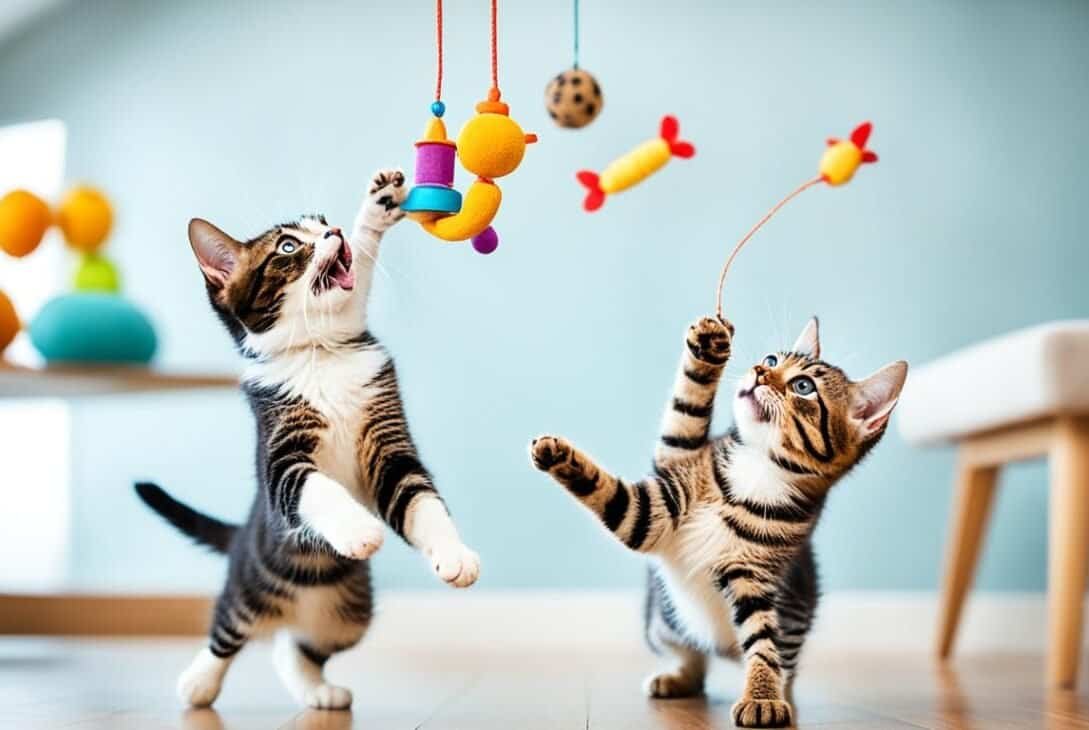
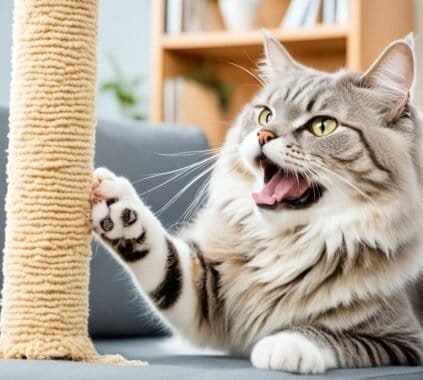
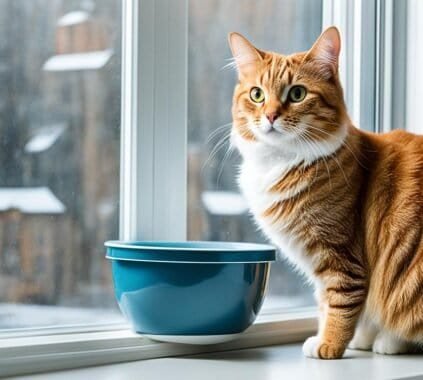
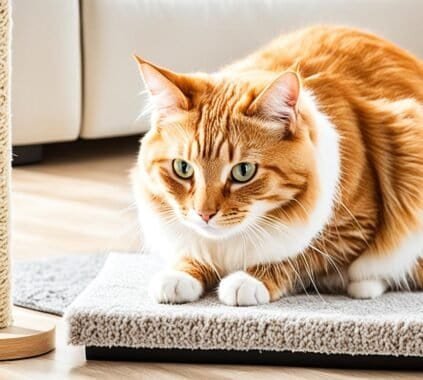









[…] you’re a cat owner, you know how important it is to keep your furry friend entertained. Cats are natural hunters and need mental and physical stimulation to stay happy and healthy. One great way to provide […]
[…] health by providing them with a balanced, species-appropriate diet. Opt for specially formulated cat food that contains all the necessary nutrients to keep your cat healthy and happy. Consult with your veterinarian to create a diet plan that suits your cat’s specific […]
[…] Reinforcement: Cats respond well to positive reinforcement techniques. When your cat exhibits a desired behavior, immediately reward them with praise, treats, or […]
[…] training is another popular positive reinforcement technique. By associating the sound of a clicker with rewards, you can effectively communicate with your cat […]
[…] Positive reinforcement is a highly effective cat training technique that focuses on encouraging desired behaviors through rewards and praise. By using this method, you can create a positive learning environment for your feline friend and strengthen your bond. Let’s explore how you can incorporate positive reinforcement into your cat’s training routine. […]
[…] vital component of mental stimulation is feline behavior training. Understanding your cat’s behavior and implementing positive reinforcement techniques can greatly enhance their cognitive abilities. When training your cat, focus on rewarding desired […]
[…] […]